| Article ID | Journal | Published Year | Pages | File Type |
|---|---|---|---|---|
| 189399 | Electrochimica Acta | 2011 | 8 Pages |
Numerous transition metal–carbon composite catalysts (M = V, Zn, Ni, Sn, Ce, Ba, Fe, Cu) have been synthesized and tested for electroreduction of O2 to H2O2, The activity and selectivity of all synthesized catalysts for electrosynthesis of H2O2 were determined by the rotating ring-disk electrode method in acidic and neutral electrolytes. The Co-based catalysts in general showed the highest activity towards H2O2 formation. Experiments with different loading contents of Co showed that the activation overpotential losses of oxygen reduction to H2O2 reduces as loading increases to about 4 wt% Co. Addition of Co beyond this level did not seem to impact the overpotential losses. The cobalt-based catalysts, were spray-coated onto 120 μm thick Toray® graphite substrates, and were studied in bulk electrolysis cells for up to 100 h at potentiostatic conditions (0.25 V vs. RHE) in pH 0, 3, and 7 electrolytes. At (25 °C and 1 bar) with a catalysts loading of about 1 mg cmgeometric−2 and using dissolved O2 in 0.5 M H2SO4, typical H2O2 electrosynthesis rates of about 5 μmol h−1 cmgeometric−2 were reached with current efficiencies of about 85 ± 5% at 0.25 V (vs. RHE).
► Numerous transition metal carbon composite catalysts are synthesized under N2 flow at 900 °C. ► Oxygen reduction activity of these catalysts towards H2O2 generation was studied. ► Co-carbon composites, made from inexpensive nitrate salts, showed highest activity.
